Meet the UN/BOX Solution Overview Cisco UCS X-Series Modular System with Intersight
Available Languages
Bias-Free Language
The documentation set for this product strives to use bias-free language. For the purposes of this documentation set, bias-free is defined as language that does not imply discrimination based on age, disability, gender, racial identity, ethnic identity, sexual orientation, socioeconomic status, and intersectionality. Exceptions may be present in the documentation due to language that is hardcoded in the user interfaces of the product software, language used based on RFP documentation, or language that is used by a referenced third-party product. Learn more about how Cisco is using Inclusive Language.
Every day, every minute, every second, new apps are launching.
The beating heart of innovation, applications are the direct expression of consumer demand and your presence. Apps have forced a whole new way of thinking on IT. The old rules no longer apply. It’s not on premises vs. cloud. It’s both. It’s massive scale and granular control. It’s always-on availability enabled by modular components that can be molded and shaped to the needs of your applications. It’s a new game where developers are free to write their own rules but where IT must free itself from the burden of managing massive complexity in order to keep up.
Tomorrow thinks differently, wanting hardware that thinks like software. The Cisco UCS® X-Series Modular System with Intersight is a modular system managed from the cloud. It is designed and shaped to meet the needs of modern applications and improve operational efficiency, agility, and scale through an adaptable, future-ready, modular design. Cisco UCS X-Series has won four CRN awards because of this.
Designed to be managed exclusively from the cloud
● Simplify with cloud-operated infrastructure.
● Simplify with an adaptable system designed for modern applications.
● Simplify with a system engineered for the future.
Support a broader range of workloads
A single server type supporting a broader range of workloads means fewer different products to support, reduced training costs, and increased flexibility. The system supports workloads including the following:
● Virtualized workloads
● Private cloud
● Enterprise applications
● GPU-accelerated AI/ML workloads
● Database management systems
● Infrastructure applications
● Cloud-native applications
● In-memory databases
● Big data clusters
The Cisco UCS X-Series Modular System simplifies your data center, adapting to the unpredictable needs of modern applications while also providing for traditional scale-out and enterprise workloads. It reduces the number of server types to maintain, helping to improve operational efficiency and agility as it helps reduce complexity. Powered by the Cisco Intersight® cloud-operations platform, it shifts your thinking from administrative details to business outcomes—with hybrid cloud infrastructure that is assembled from the cloud, shaped to your workloads, and continuously optimized. Now that hardware can think and change like software, you are free to think like tomorrow.
Simplify your data center
Since we first delivered the Cisco Unified Computing System™ (Cisco UCS) in 2009, our goal has been to simplify your data center. We pulled management out of servers and into the network. We simplified multiple networks into a single unified fabric. And we eliminated network layers in favor of a flat topology wrapped up into a single unified system. With the Cisco UCS X-Series Modular System we take that simplicity to the next level:
● Simplify with cloud-operated infrastructure: We move management from the network into the cloud so that you can respond at the speed and scale of your business and manage all of your infrastructure. Shape Cisco UCS X-Series Modular System resources to workload requirements with the Cisco Intersight cloud-operations platform. Integrate third-party devices including storage from NetApp, Pure Storage, and Hitachi. Gain intelligent visualization, optimization, and orchestration for all of your applications and infrastructure. Automation drives agility and consistency, helping you reduce time to market while lowering cost and risk.
● Simplify with an adaptable system designed for modern applications: Today’s cloud-native, hybrid applications are inherently unpredictable. They get deployed and redeployed as part of an iterative DevOps practice. Requirements change often and you need a system that doesn’t lock you into one set of resources when you find that you need another. For hybrid applications, and a range of traditional data center applications, you can consolidate onto a single platform that combines the density and efficiency of blade servers with the expandability of rack servers. The result: better performance, automation, and efficiency.
● Simplify with a system engineered for the future: Embrace emerging technology and reduce risk with a modular system designed to support future generations of processors, storage, nonvolatile memory, accelerators, and interconnects. Gone is the need to purchase, configure, maintain, power, and cool discrete management modules and servers. Cloud-based management is kept up to date automatically with a constant stream of new capabilities delivered by the Intersight software-as-a-service model.
It doesn’t get simpler than this:
The Cisco UCS X9508 Chassis is ready to house technology for today with an approach that embraces the future. Just slide into the chassis what you need today. Embrace the future without needing a forklift.
Our chassis is free from what we call parasitic hardware—switches and management modules that must be purchased, configured, powered, cooled, and maintained. They draw from the chassis power and cooling budget while reducing the space allocated to servers. The chassis’ midplane-free design eliminates limitations on future I/O interconnect technology.
The Cisco UCS X-Series Modular System begins with a chassis engineered to be adaptable and flexible. This makes it ready to power a wider range of workloads and ready to adapt to the future because there is nothing holding it back.
Our chassis has only a power-distribution midplane. For I/O connectivity, vertically oriented compute nodes intersect with horizontally oriented I/O connectivity components with blind-mating connectors (Figure 1). As future networking and I/O standards emerge, they can mate to different connectors, unboxing the future of computing without requiring a new chassis.
The 7-Rack-Unit (7RU) chassis has eight flexible slots. These can house a combination of compute nodes and PCIe nodes with other Cisco UCS X-Fabric connectivity modes and expansion node types planned for the future.
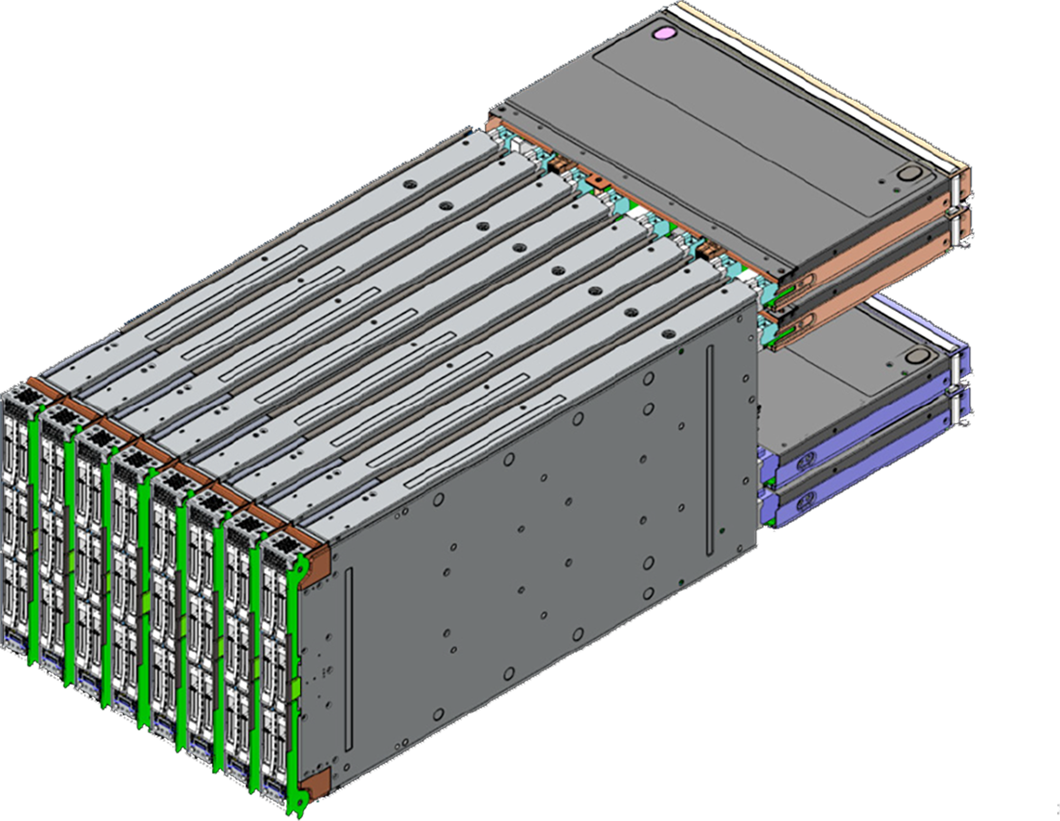
The midplane-free design gives the chassis the capability to adapt to new technology—such as X-Fabric modules—as it emerges
At the top rear of the chassis are two intelligent fabric modules that connect the chassis to upstream Cisco UCS 6400, 6500, and UCS 6600 Series Fabric Interconnects. At the bottom are slots that house optional X-Fabric modules that connect to I/O expansion nodes within the chassis.
Six 2800W Power Supply Units (PSUs) provide 54V power to the chassis with N, N+1, and N+N redundancy. A higher voltage allows efficient power delivery with less copper and reduced power loss. Efficient, 100mm, dual counter-rotating fans deliver industry-leading airflow and power efficiency.
Optimized thermal algorithms enable different cooling modes to best support your environment. Cooling is modular so that future enhancements can potentially handle open- or closed-loop liquid cooling to support even higher-power processors. All these design and operation advantages add up to enable the UCS X-Series to not only meet but exceed sustainability benchmarks such as Energy Star, EPEAT, EU regulation 2019/424, and many others. UCS X-Series won the 2023 SEAL Sustainable Product and Silverlinings Cloud Innovation Sustainability Solution awards.
A unified fabric interconnects all devices in the system. It securely carries all traffic to the fabric interconnects where it can be broken out into IP networking, Fabre Channel SAN, and management connectivity.
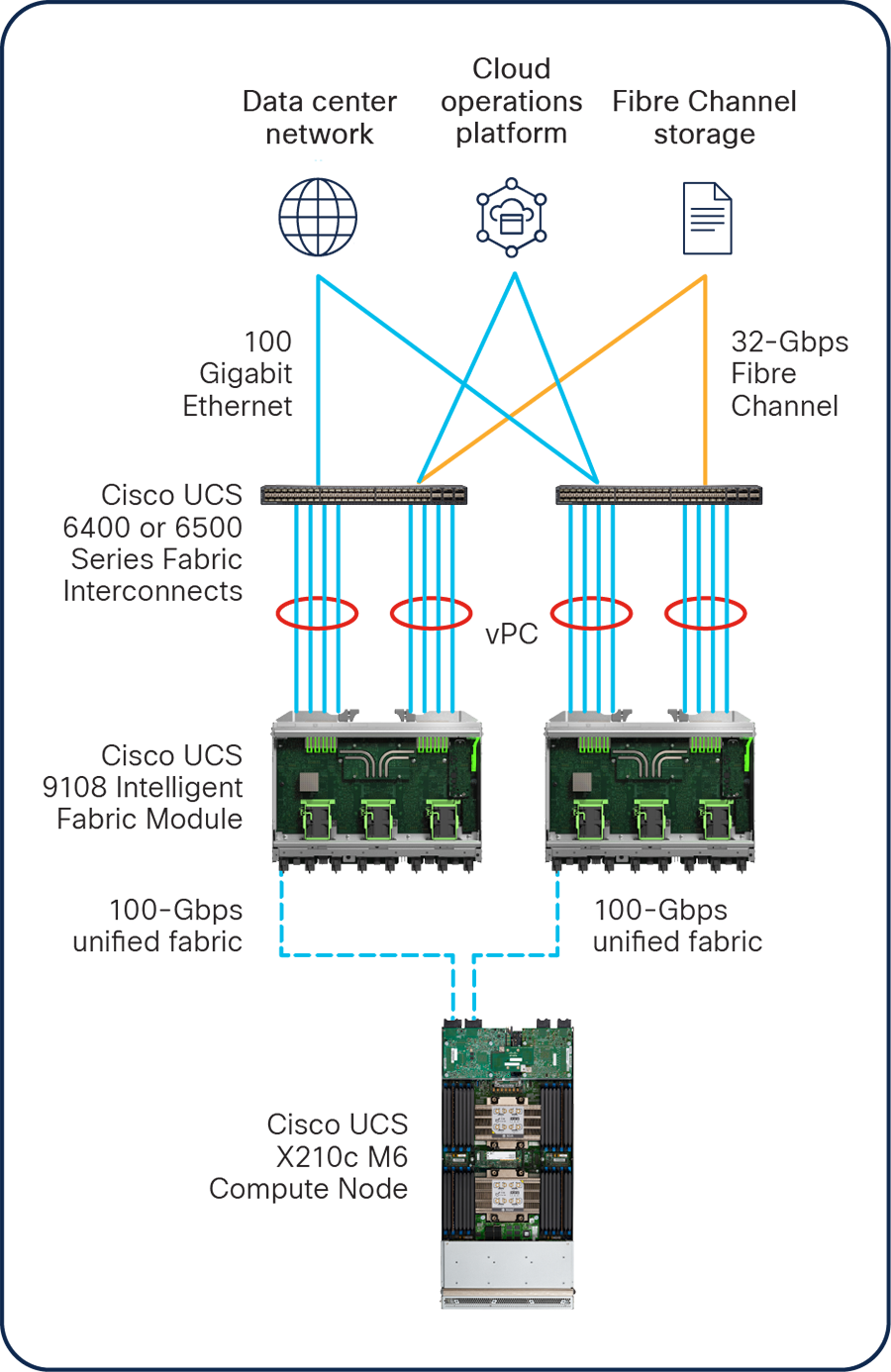
Unified fabric connectivity
In contrast to systems with fixed network and I/O traces on a chassis midplane, our midplane-free design enables easy upgrades to new connectivity technologies as they emerge. Horizontally oriented modules mate with I/O connectors on each vertically oriented compute and PCIe node, making it straightforward to accommodate new network and modular expansion speeds and modalities in the future.
Network connectivity
Network connectivity is provided by a pair of Cisco UCS 9108 Intelligent Fabric Modules (IFMs) with 25- or 100-Gbps connectivity. These modules carry all network traffic to a pair of Cisco UCS 6400, 6500, and 6600 Series Fabric Interconnects. Having a single point of network connectivity and control in a system provides deterministic latency. This, in turn, frees you to place workloads without regard to whether the compute nodes are in the same chassis. Each IFM features (Figure 2):
● Server ports: Up to 200 Gbps of unified fabric connectivity per compute node with two IFMs.
● Uplink ports: The Cisco UCS 9108 25G IFM supports 8x 25-Gbps SFP28 ports, while the 100G option supports 8x 100-Gbps QSFP ports. The unified fabric carries management, production, and storage traffic to the fabric interconnects. There, management traffic connects to the Cisco Intersight cloud-operations platform; storage traffic is passed to native Fiber Channel interfaces through universal ports on the fabric interconnects, and production Ethernet traffic is passed upstream to the data center network.
● Management consolidation: Each IFM connects to the Cisco® Integrated Management Controller on each compute node, enabling Intersight access to configuration and monitoring capabilities. It also connects to the chassis, power supply, and fan speed and temperature sensors, enabling both zone-based cooling and policy-based power management.
Cisco UCS X-Series Direct
Cisco UCS X-Series Direct transforms the Cisco UCS X-Series Modular System into a self-contained system with a pair of integrated fabric interconnects and up to eight server nodes. Replacing the IFMs with the Cisco UCS Fabric Interconnect 9108 100G provides you an all-in-one solution of up to eight servers with optional GPUs, eliminating the need for Top-of-Rack (ToR) fabric interconnects. You will use your existing Ethernet and optional Fibre Channel switches for data and storage connectivity. UCS X-Series Direct is an ideal solution for all your edge, retail, and small- or remote-office use cases.
Cisco UCS X-Fabric connectivity
We chose X-Fabric Technology to describe our innovative modular connectivity approach because “X” is a variable that can evolve with new technology developments designed to create a modular pool of resources in each chassis.
The Cisco UCS 9416 X-Fabric Modules connect Cisco UCS X210c, X215c, and X410c server nodes to Cisco UCS X440p PCIe Nodes, and the Cisco UCS 9516 X-Fabric Module connects those servers to the Cisco UCS X580p PCIe Node. Tested and validated devices are AMD and NVIDIA GPUs appropriate for accelerating AI/ML and VDI applications. Combined with two onboard cards, the compute nodes can accelerate workloads with up to six GPUs per node.
What we offer today is just the beginning, as we have plans for our vision to unfold into the future. Look forward to a wider range of PCIe devices, disk storage, and nonvolatile memory resources so that your compute nodes become powerful, flexible computing devices that can adapt to support any workload.

The Cisco UCS X9508 Modular System Chassis supports a wide range of workloads and is expandable with Cisco UCS X-Fabric devices
Cisco UCS virtual interface cards
Configuring your Cisco UCS X-Series Compute Node with both mLOM- and mezzanine-form-factor virtual interface cards delivers up to 200 Gbps of network bandwidth to the node and connects it to Cisco UCS X-Fabric nodes.
The number and types of I/O devices are configured on demand through Cisco Intersight or Cisco UCS Manager.
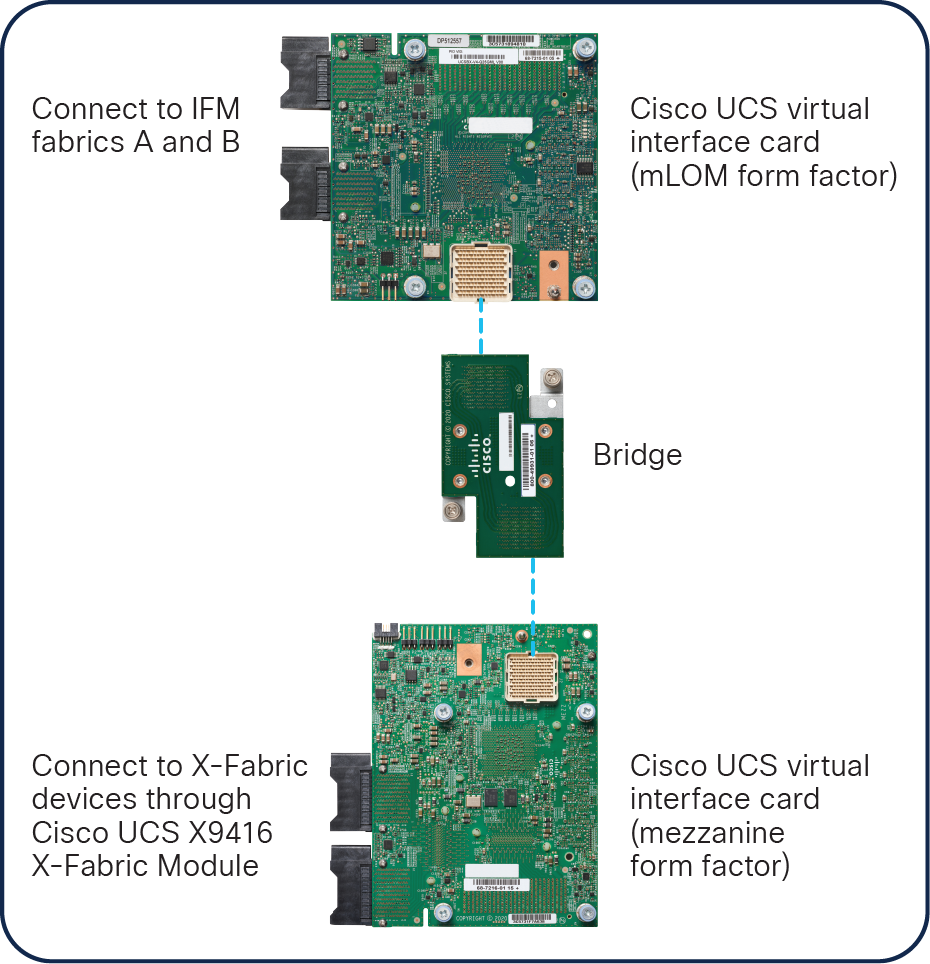
Cisco UCS Virtual Interface Cards in mLOM and mezzanine form factors, with mezzanine bridge module
The Cisco UCS X9508 Chassis is designed to house and interconnect a variety of computing and I/O devices. Up to eight nodes can fit into a single chassis.
There are four compute node models:
● Cisco UCS X215c M8 Compute Node
◦ CPU: Up to 2x 5th or 4th Gen AMD EPYC CPUs with up to 192 cores per processor and up to 1152 MB Level 3 cache per CPU.
◦ Memory: Up to 24x 256 GB DDR5-6000 DIMMs for up to 6 TB of main memory.
● Cisco UCS X210c M8 Compute Node
◦ CPU: Up to 2x Intel Xeon® 6 Processors with up to 86 cores per processor and up to 336 MB Level-3 cache per CPU.
◦ Memory: Up to 32x 256 GB DDR5-6400 DIMMs for up to 8 TB of main memory. Support for MRDIMM post FCS.
● Cisco UCS X210c M7 Compute Node
◦ CPU: Up to 2x 5th or 4th Gen Intel Xeon Scalable Processors with up to 64 cores per processor and up to 320 MB Level 3 cache per CPU.
◦ Memory: Up to 32x 256 GB DDR5-5600 DIMMs for up to 8 TB of main memory.
● Cisco UCS X410c M7 Compute Node
◦ CPU: 4x 4th Gen Intel Xeon Scalable Processors with up to 60 cores per processor and up to 2.625 MB Level-3 cache per core and up to 112.5 MB per CPU.
◦ Memory: Up to 64x 256 GB DDR5-4800 DIMMs for up to 16 TB of main memory.
Common features across the compute family:
● Disk storage: There are three front storage mezzanines for compute nodes. All servers support up to 6 SAS or SATA drives can be configured with an internal RAID controller, or up to 6 NVMe drives with four lanes each of PCIe Gen4 connectivity, and up to two M.2 SATA memory cards can be configured with RAID 1 mirroring or two M.2 NVMe in pass-through mode. An optional PCIe mezzanine module supports up to two GPU accelerators, and two NVMe drives are supported on all two-socket compute nodes. For M8 compute nodes, there is an option for up to 9 ES.3 NVMe drives. Overall, the storage configuration delivers the capacity of many rack servers with the convenience of the modular form factor, adding to the system’s capability to support a wide range of workloads.
● mLOM virtual interface cards: These cards fit into the upper mLOM slot in the node. The Cisco UCS Virtual Interface Card (VIC) 15231 and VIC 15230 secure boot provides 2x 100 Gbps of unified fabric connectivity to the chassis IFM, and the Cisco UCS VIC 14425 provides up to 2x 50 Gbps of connectivity. The VIC 15420 mLOM provides up to 4x 25 Gbps of connectivity with secure boot support. Combined with Mezzanine-format VICs, the chassis can eventually scale up to 400 Gbps of connectivity per node. Cisco virtual interface cards enable the number and type of I/O devices presented to the operating system to be configured on demand through Cisco Intersight.
● Mezzanine virtual interface card: The optional Cisco UCS VIC 14825 and VIC 15422 can occupy the server’s mezzanine. A bridge card extends these VIC’s 2x 50 Gbps of network connections to the mLOM slot. The mLOM VIC 14425 can be paired with the VIC 14825 and the mLOM VIC 15420 with the VIC 15422 to support additional network bandwidth and interfaces. Additionally, these cards link to optional Cisco UCS X9416 X-Fabric Modules that integrate PCIe devices into server nodes.
● Security: The server supports an optional Trusted Platform Module (TPM). Additional features include a secure boot FPGA and ACT2 anti-counterfeit provisions.
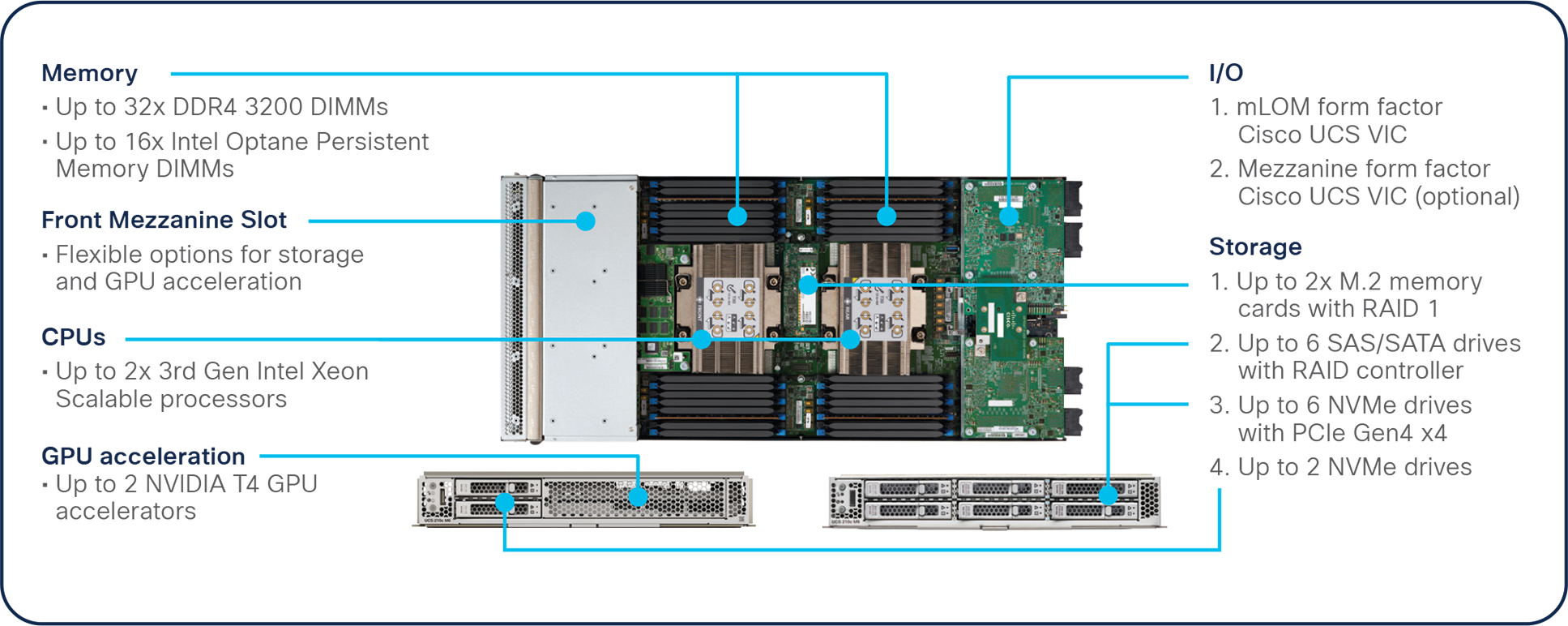
Representative example of two-socket compute node for the Cisco UCS X-Series Modular System
Single point of connectivity for the system
Cisco UCS 6400, 6500, and 6600 Series Fabric Interconnects provide a single point of connectivity for the system. Multiple Cisco UCS X9508 Chassis can be connected to the interconnects along with any other servers in the Cisco UCS product lines, up to a maximum of 160 servers.
The fabric interconnects provide line-rate, lossless connectivity for all traffic within a system. Rather than distributing switching functions into the chassis, the fabric interconnects maintain deterministic latency between all compute nodes regardless of whether they reside in the same chassis. As with the intelligent fabric modules, both 25- and 100-Gbps fabric interconnects can interconnect a single Cisco Unified Computing System with up to 16x 100-Gbps connections to each X-Series chassis. Each fabric interconnect links to the Cisco Intersight cloud-operations platform.
Cisco Intersight Secure Connect technology
With the Cisco UCS X-Series Modular System, you don’t have to host multiple management servers, software, and networks in your data center. Cisco Intersight Secure Connect technology reaches from the cloud to the fabric interconnects with connectivity as secure as when management traffic is on a protected physical network. Once you claim the fabric interconnects in the Intersight GUI, the systems become self-aware, incorporating any new compute nodes as they are plugged in. Cisco Intersight Secure Connect technology makes it possible for Intersight to manage not just the entire Cisco UCS product line, but also storage systems from the leading storage vendors, including NetApp, Pure Storage, and Hitachi. This technology is a strategic investment on our part in that it is a thin layer of software that can quickly expand the universe of supported devices, enabling you to stay ahead of new technology developments.
Ready for a hybrid-cloud world
The Cisco Intersight cloud-operations platform is the force that transforms the Cisco UCS X-Series Modular System from a set of components into a flexible server platform to propel your most important workloads.
The Cisco UCS X-Series with Intersight is built with a common purpose: to make hardware think like software so that you can easily adapt to a rapidly changing world. Through server profiles, Intersight defines the identity, connectivity, and I/O configuration of your servers and automates the entire infrastructure lifecycle. It’s easy to imagine how, as more features are released, the modular system supports a pool of I/O resources: banks of nonvolatile memory, GPU accelerators, specialized ASICs, and massive amounts of NVMe storage. Just as the chassis and Cisco UCS X-Fabric Technology are designed to incorporate a constant flow of new capabilities, Cisco Intersight is designed to automatically integrate those technologies into servers along with a constant flow of new, higher-level management capabilities. Software as a Service (SaaS) meets modular, infrastructure as code, and the line between hardware and software dissolves.
With Cisco Intersight and the Cisco UCS X-Series you can:
● Define desired system configurations based on policies that use pools of resources provided by the Cisco UCS X-Series. Let Cisco Intersight assemble the components and set up everything from firmware levels to which I/O devices are connected. Infrastructure is code, so your IT organization can use the Intersight GUI and your DevOps teams can use the Intersight API, the Intersight Service for HashiCorp Terraform, or the many API bindings from languages such as Python and PowerShell.
● Deploy from the cloud to any location. Anywhere the cloud reaches, Intersight can automate your IT processes.
● Optimize your workload by analyzing runtime performance and make resource adjustments and workload placements to keep response time within a desired range. If your first attempt at matching resources to workloads doesn’t deliver the results you need, you can reshape the system quickly and easily. Cisco Intersight facilitates deploying workloads into your private cloud and into the public cloud. Now one framework bridges your core, cloud, and edge infrastructure, managing infrastructure and workloads wherever they are deployed.
● Maintain your infrastructure with a consolidated dashboard of infrastructure components regardless of location. Ongoing telemetry and analytics give early detection of possible failures. Reduce risk of configuration drift and inconsistent configurations through automation with global policy enforcement.
● Support your infrastructure with AI-driven root-cause analysis and automated case support for the always-connected Cisco Technical Assistance Center (Cisco TAC). Intersight watches over you when you update your solution stack, helping to prevent incompatible hardware, firmware, operating system, and hypervisor configurations.
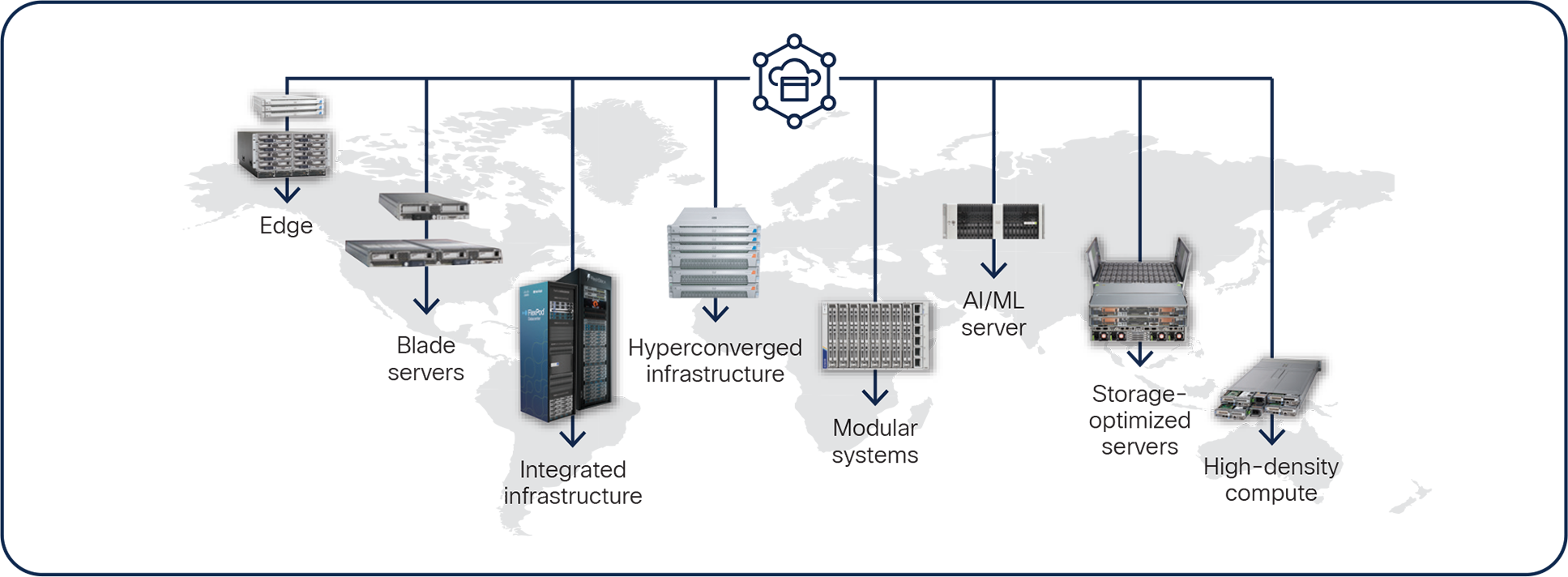
Cisco Intersight reaches from the cloud to all of your infrastructure, regardless of its location
Modular management architecture
Cisco Intersight is a modular set of services that bridge applications and infrastructure to meet your specific needs, including:
● Cisco Intersight: Manage Cisco data-center products, Cisco converged infrastructure solutions, and third-party endpoints.
The Cisco UCS X-Series Modular System is ready for your data center today, and ready to serve it well into the future with an architecture designed to support many future processor generations and multiple innovations in server I/O, networking, and infrastructure. With cloud-based lifecycle management and a simplified yet adaptable system, we continue to help you simplify your data center:
● Simplify with cloud-operated infrastructure: Respond at the speed and scale of your business by shaping Cisco UCS X-Series Modular System resources to workload requirements with Intersight. Deliver intelligent visualization, optimization, and orchestration to all your applications and infrastructure.
● Simplify with an adaptable system designed for modern applications: Adapt to the unpredictable requirements of modern applications. Consolidate onto a single platform that combines the density and efficiency of blade servers with the expandability of rack servers for better performance, automation, and efficiency.
● Simplify with a system engineered for the future: Embrace emerging technology and reduce risk with a modular system engineered to support future generations of processors, accelerators, and interconnects with management enabled by a constant stream of new capabilities delivered as SaaS.
Visit www.cisco.com/go/ucsx.